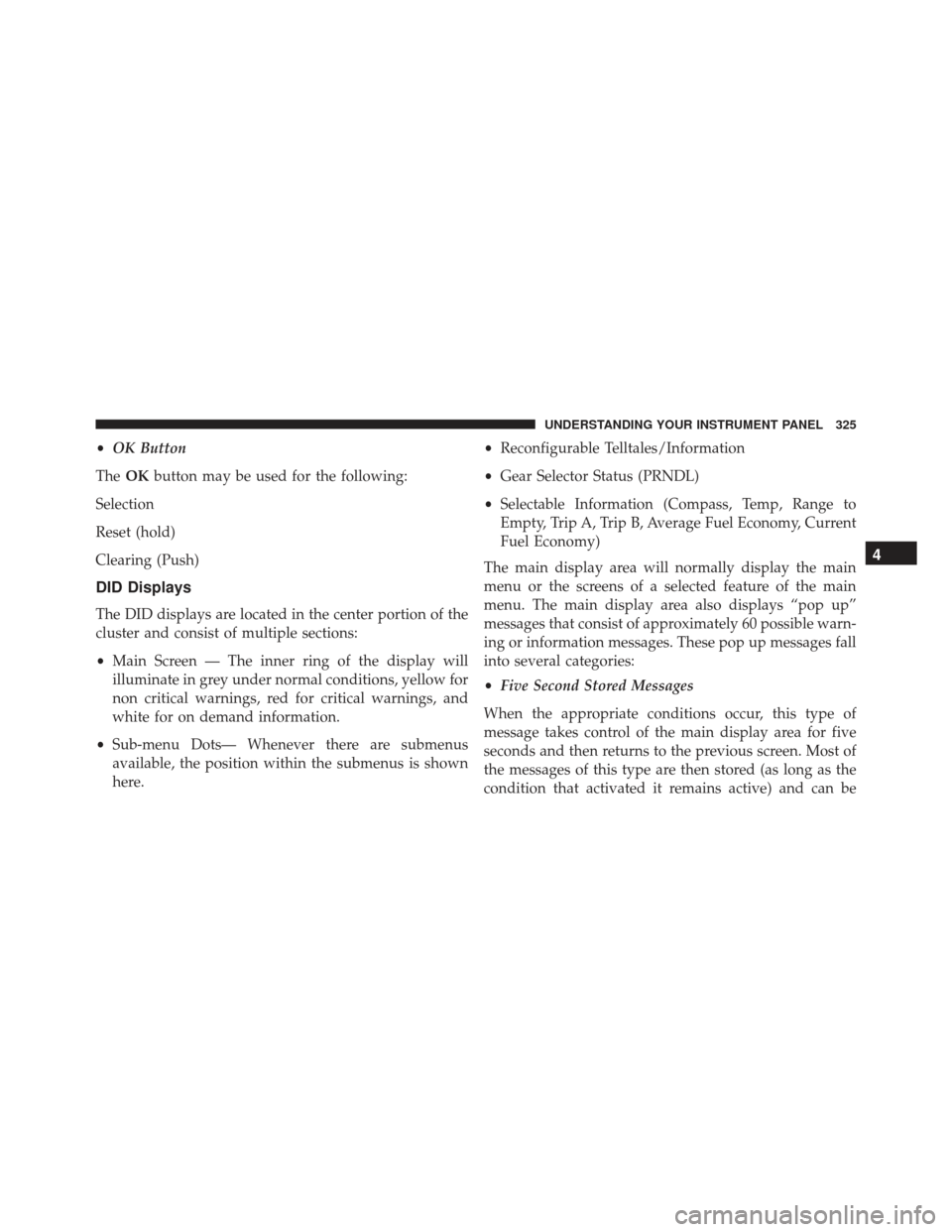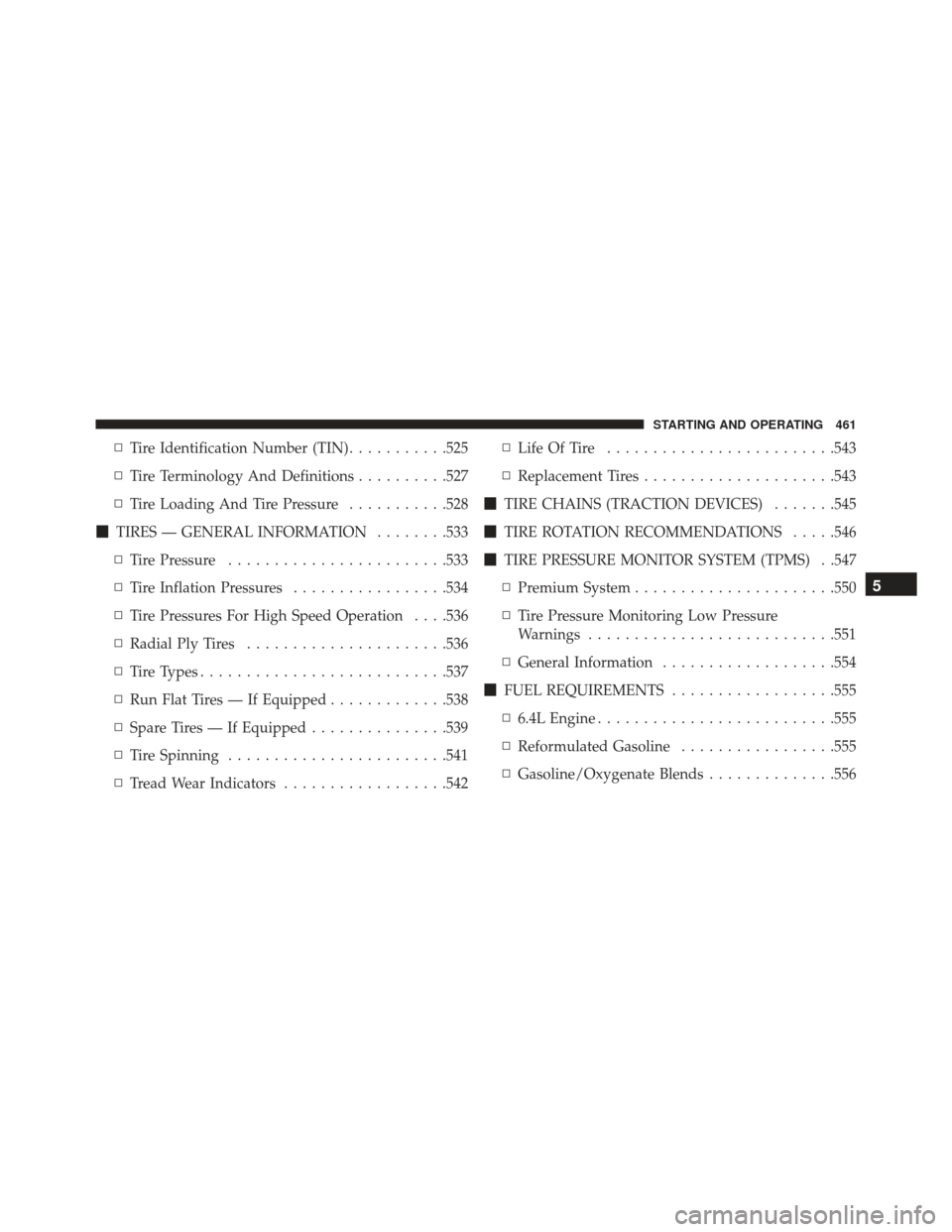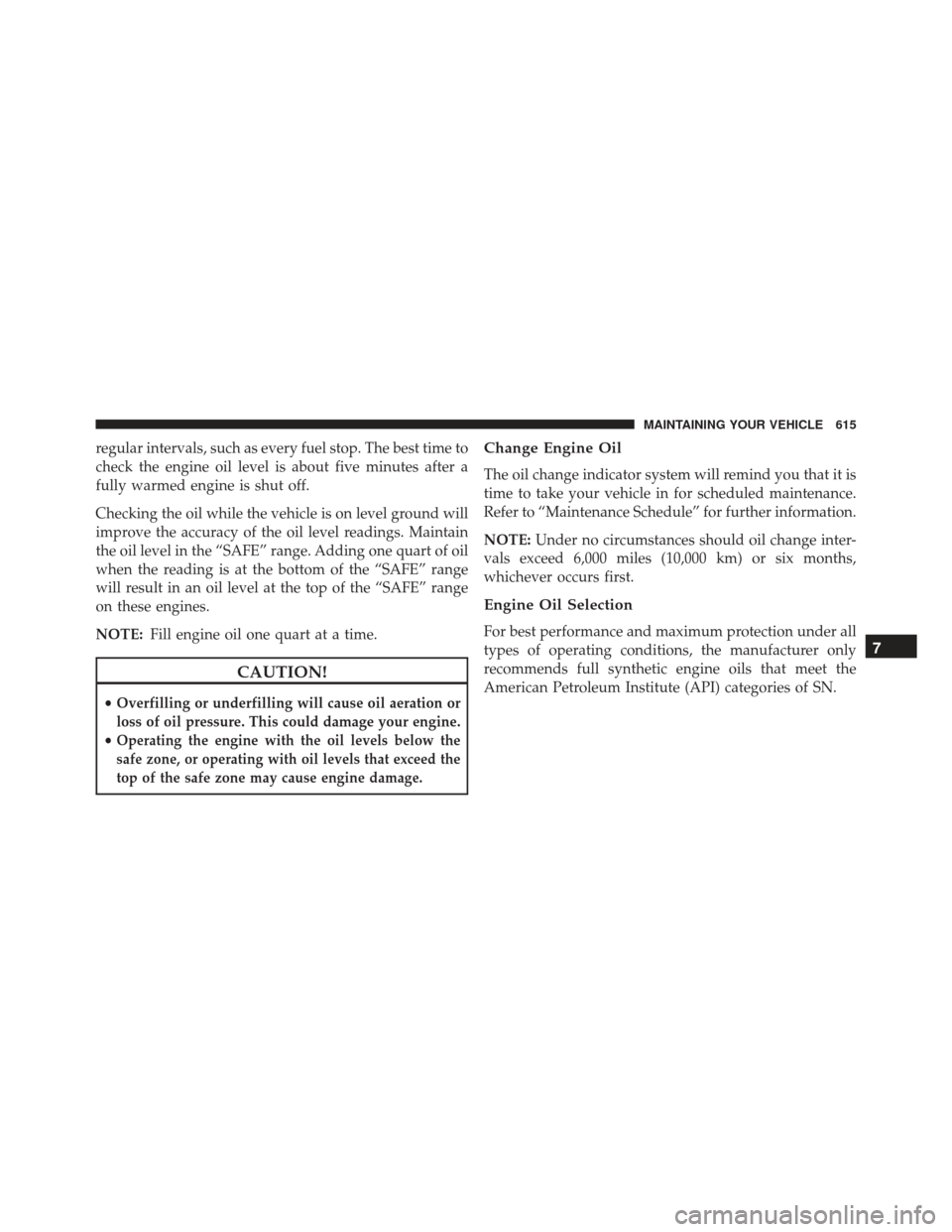Page 327 of 723

•OK Button
The OKbutton may be used for the following:
Selection
Reset (hold)
Clearing (Push)
DID Displays
The DID displays are located in the center portion of the
cluster and consist of multiple sections:
• Main Screen — The inner ring of the display will
illuminate in grey under normal conditions, yellow for
non critical warnings, red for critical warnings, and
white for on demand information.
• Sub-menu Dots— Whenever there are submenus
available, the position within the submenus is shown
here. •
Reconfigurable Telltales/Information
• Gear Selector Status (PRNDL)
• Selectable Information (Compass, Temp, Range to
Empty, Trip A, Trip B, Average Fuel Economy, Current
Fuel Economy)
The main display area will normally display the main
menu or the screens of a selected feature of the main
menu. The main display area also displays “pop up”
messages that consist of approximately 60 possible warn-
ing or information messages. These pop up messages fall
into several categories:
• Five Second Stored Messages
When the appropriate conditions occur, this type of
message takes control of the main display area for five
seconds and then returns to the previous screen. Most of
the messages of this type are then stored (as long as the
condition that activated it remains active) and can be
4
UNDERSTANDING YOUR INSTRUMENT PANEL 325
Page 463 of 723

▫Tire Identification Number (TIN) ...........525
▫ Tire Terminology And Definitions ..........527
▫ Tire Loading And Tire Pressure ...........528
� TIRES — GENERAL INFORMATION ........533
▫ Tire Pressure ....................... .533
▫ Tire Inflation Pressures .................534
▫ Tire Pressures For High Speed Operation . . . .536
▫ Radial Ply Tires ..................... .536
▫ Tire Types .......................... .537
▫ Run Flat Tires — If Equipped .............538
▫ Spare Tires — If Equipped ...............539
▫ Tire Spinning ....................... .541
▫ Tread Wear Indicators ..................542 ▫
Life Of Tire ........................ .543
▫ Replacement Tires .....................543
� TIRE CHAINS (TRACTION DEVICES) .......545
� TIRE ROTATION RECOMMENDATIONS .....546
� TIRE PRESSURE MONITOR SYSTEM (TPMS) . .547
▫ Premium System ..................... .550
▫ Tire Pressure Monitoring Low Pressure
Warnings .......................... .551
▫ General Information ...................554
� FUEL REQUIREMENTS ..................555
▫ 6.4L Engine ......................... .555
▫ Reformulated Gasoline .................555
▫ Gasoline/Oxygenate Blends ..............556
5
STARTING AND OPERATING 461
Page 469 of 723

WARNING!(Continued)
•Do not attempt to push or tow your vehicle to get it
started. Vehicles equipped with an automatic trans-
mission cannot be started this way. Unburned fuel
could enter the catalytic converter and once the
engine has started, ignite and damage the converter
and vehicle.
• If the vehicle has a discharged battery, booster
cables may be used to obtain a start from a booster
battery or the battery in another vehicle. This type
of start can be dangerous if done improperly. Refer
to “Jump-Starting” in “What To Do In Emergen-
cies” for further information.
Clearing A Flooded Engine (Using ENGINE
START/STOP Button)
If the engine fails to start after you have followed the
“Normal Starting” or “Extreme Cold Weather� proce-
dures, it may be flooded. To clear any excess fuel:
1. Press and hold the brake pedal.
2. Press the accelerator pedal all the way to the floor and hold it.
3. Push and release the ENGINE START/STOP button once.
The starter motor will engage automatically, run for 10
seconds, and then disengage. Once this occurs, release
the accelerator pedal and the brake pedal, wait 10 to 15
seconds, then repeat the “Normal Starting” procedure.
5
STARTING AND OPERATING 467
Page 617 of 723

regular intervals, such as every fuel stop. The best time to
check the engine oil level is about five minutes after a
fully warmed engine is shut off.
Checking the oil while the vehicle is on level ground will
improve the accuracy of the oil level readings. Maintain
the oil level in the “SAFE” range. Adding one quart of oil
when the reading is at the bottom of the “SAFE” range
will result in an oil level at the top of the “SAFE” range
on these engines.
NOTE:Fill engine oil one quart at a time.
CAUTION!
•Overfilling or underfilling will cause oil aeration or
loss of oil pressure. This could damage your engine.
•Operating the engine with the oil levels below the
safe zone, or operating with oil levels that exceed the
top of the safe zone may cause engine damage.
Change Engine Oil
The oil change indicator system will remind you that it is
time to take your vehicle in for scheduled maintenance.
Refer to “Maintenance Schedule” for further information.
NOTE: Under no circumstances should oil change inter-
vals exceed 6,000 miles (10,000 km) or six months,
whichever occurs first.
Engine Oil Selection
For best performance and maximum protection under all
types of operating conditions, the manufacturer only
recommends full synthetic engine oils that meet the
American Petroleum Institute (API) categories of SN.
7
MAINTAINING YOUR VEHICLE 615
Page 678 of 723
FLUIDS, LUBRICANTS, AND GENUINE PARTS
Engine
ComponentFluid, Lubricant or Genuine Part
Engine Coolant We recommend you use MOPAR Antifreeze/Coolant 10 Year/150,000 Mile
Formula OAT (Organic Additive Technology) that meets the requirements
of FCA Material Standard MS.90032.
Engine Oil For best performance and maximum protection under all types of operating
conditions, the manufacturer only recommends full synthetic engine oils
that meet the American Petroleum Institute (API) categories of SN.
The manufacturer recommends the use of Pennzoil Ultra 0W-40 or equiva-
lent MOPAR engine oil meeting the requirements of FCA Material Standard
MS-12633 for use in all operating temperatures.
Engine Oil Filter We recommend you use MOPAR Engine Oil Filters.
Spark Plugs We recommend you use MOPAR Spark Plugs.
Fuel Selection Premium Unleaded 91 Octane Only or Higher, 0-15% Ethanol.
676 MAINTAINING YOUR VEHICLE